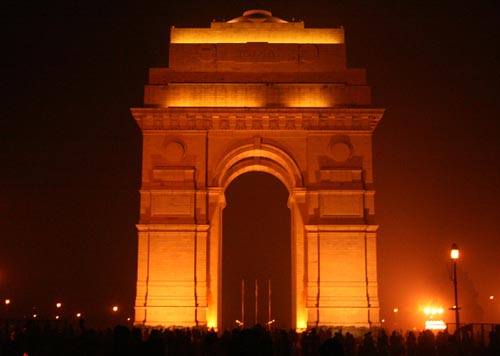India Gate Delhi

Information on India Gate (New Delhi) - History & Architecture
The India Gate was earlier christened as the All India War Memorial which honours 70,000 brave Indian soldiers who laid down their respective lives in the World War I while serving the British Army. The monument appears like a portico amid a cross road in the heart of New Delhi. It is stated to be a war cenotaph situated across the Rajpath, at the east end of New Delhi, previously known as Kingsway. The walls of the cenotaph are inscribed with the names of above 13,516 Indian as well as British soldiers who were executed in the Northwest Frontier of the Afghan war in the year 1919.
India Gate Delhi Architecture
The India Gate stands tall with a height of 42 metres and was designed in an arch shape pattern by Edwin Lutyens, a distinguished architect as well as leading war cenotaph designer. Lutyens is also responsible for designing the city of New Delhi. The inspiration of the design was derived from the monument, Arc de Triomphe in Paris. The final completion of the monument was done in the year 1931. The foundation stone of the monument was put down in the year 1921 by His Royal Highness, the Duke of Connaught. The structure rests on a low down base that is made of red coloured Bharatpur stones and climbs high in phases ultimately resulting in an enormous moulding. The top of the structure consists of a low arched bowl which was constructed with the purpose of being lighted with the help of burning oil on the occasion of anniversaries which has become quite a rare affair in the recent times. The monument is basically a complex in the shape of a hexagon which includes a width of around 625 metres and roughly covers an area of 306,000 square metres.
India Gate Delhi History
The All-India War Memorial or rather the India Gate, similar to the popular Cenotaph situated in London, rules out the influence of any kind of culturally or religiously inclined form of iconography for instance crosses. It was found from a study on Lutyens that the architectural pattern of the monument was designed based on an universal architectural approach which was free from the reins of religious adornment. The India Gate is considered to be the fundamental landscape and chief official procession road in New Delhi. It was learnt that in between the period of putting down the foundation stone of the monument and its inaugural ceremony, the rail-line had to be repositioned along the river Yamuna which resulted in the inauguration of the New Delhi Railway Station in the year 1926. India Gate was learnt to be devoted to the country after 10 long years by the Viceroy, Lord Irwin. An additional memorial, Amar Jawan Jyoti was constructed much later in the year 1971 in the remembrance and honour of the Indian soldiers who gave up their lives while fighting during the Indo-Pak war. A flame was lit in order to pay tribute to the soldiers and keeps burning till date for 24 hours.
India Gate Delhi Tourism Significance
India Gate owing to its significance and history relates to being a national pride. The monument offers an opportunity to the visitors to comprehend and go back over the brave deeds, dedication and passion of the soldiers for their motherland. It is considered to be amongst the biggest war monuments in India which has made it a sought after tourist destination both nationally as well as globally. The surrounding area of India Gate is also the favourite place to hang out and enjoy some wonderful time with family members, children and dear ones.
- Andaman Nicobar Monuments
- Andhra Pradesh Monuments
- Assam Monuments
- Bihar Monuments
- Chhattisgarh Monuments
- New Delhi Monuments
- Goa Monuments
- Gujarat Monuments
- Haryana Monuments
- Himachal Pradesh Monuments
- Jammu and Kashmir Monuments
- Karnataka Monuments
- Kerala Monuments
- Madhya Pradesh Monuments
- Maharashtra Monuments
- Odisha Monuments
- Punjab Monuments
- Rajasthan Monuments
- Tamil Nadu Monuments
- Telangana Monuments
- Uttar Pradesh Monuments
- West Bengal Monuments